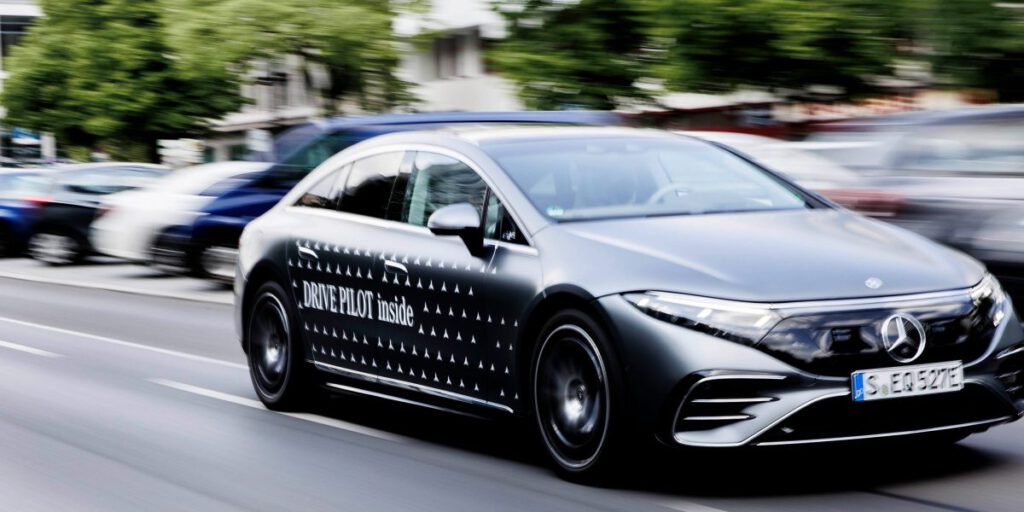Next time you’re driving down an interstate and see a driver with their hands full with something other than the wheel (scrolling TikTok, applying mascara, eating breakfast), don’t panic: As long as you’re driving a new Mercedes with self-driving technology, this is all legal in some states.
Luxury automaker Mercedes has become the first company in the U.S. to begin selling self-driving cars (at least those that offer a hands-free driving experience) to the general public. Fortune learned through an open records request filed with the California DMV that there were 65 self-driving Mercedes cars available for sale in California as of April 11. One of the cars has since been sold, the DMV said, making it the first self-driving Mercedes to be sold in California. Mercedes did not disclose the number of cars sold. Some Mercedes dealerships in Nevada are also selling cars equipped with a new technology called “Level 3” autonomy.
Mercedes told Fortune that its Level 3-capable vehicles were released in December. California and Nevada are the only two states where the company can legally sell the technology to consumers. The DMVs in those states gave Mercedes permission to start selling the cars last year, in Nevada in January and in California in June. Mercedes announced sales plans in September, but this is the first news that the cars have actually been delivered to consumers.
Drivers can activate the technology, called Mercedes Drive Pilot, when certain conditions are met, such as in heavy traffic, during the day, on certain highways in California and Nevada, and when traveling below 40 mph. Drivers can focus on other activities until the vehicle alerts them to resume control. The technology doesn’t work on roads that Mercedes hasn’t pre-approved, such as highways in other states.
The sale marks a new stage of self-driving available to average Americans. Mercedes is the first automaker to achieve Level 3 capability in the U.S., selling to customers, while Tesla and others are still offering Level 2 technology. At Level 2, the car can perform certain tasks but requires constant supervision by the driver. However, some drivers ignore these rules and drive their cars as if they were more capable than they actually are. The family of the deceased driver has accused Tesla of overselling its assisted driving technology as fully autonomous, leading to disastrous results. Meanwhile, the California DMV filed a false advertising lawsuit against the company over the incident last year.
Meanwhile, robotaxis from Alphabet Inc.’s Waymo and GM’s Cruise operate at Level 4, meaning they drive autonomously without human intervention in most situations, but the companies are not currently selling vehicles to consumers, and Cruise recently suspended its service after its license was suspended by the California DMV following an incident in which a pedestrian was dragged 20 feet under its vehicle.
U.S. customers can purchase a year’s subscription to Drive Pilot for the 2024 EQS sedan and S-Class models for $2,500. Mercedes began selling Level 3-capable vehicles in its native Germany in May 2022. A three-year membership for the European package costs between 5,000 and 7,000 euros ($5,300 to $7,500).
Mercedes is testing turquoise lights in the car’s rearview mirror, headlights and taillights to let police and other drivers know the car is driving itself. Drive Pilot is only available on certain models with built-in hardware, such as sensors on the front of the car or a camera in the rear window.
Mercedes is also working on developing Level 4 capabilities. The company’s chief technology officer, Markus Schäfer, expects Level 4 autonomous technology to be available to consumers by 2030, Automotive News reported. But making the leap to Level 4 is much harder than achieving Level 3. While Level 3 requires a human to take control of the car depending on the situation, Level 4 technology is supposed to achieve near-full autonomy. At this level, the driver only needs to take over control if the system fails, which means the technology must be able to safely handle almost any unexpected situation on the road.
Correction, April 19, 2024: An earlier version of this article misstated the number of Mercedes self-driving cars sold in California: There were 65 cars available for sale at the time of the records request.
Update, April 19, 2024: This article has been updated to include information that one self-driving car has been sold in California.
Correction, April 24, 2024: An earlier version of this article misstated the status of Mercedes’ turquoise light technology. At this time, the lights will only be installed in Mercedes test vehicles.
Recommended Newsletters: CEO Daily provides essential context for the news business leaders need to know. Every weekday morning, more than 125,000 readers trust CEO Daily for insight on and from the C-level. Subscribe now.
Source link

